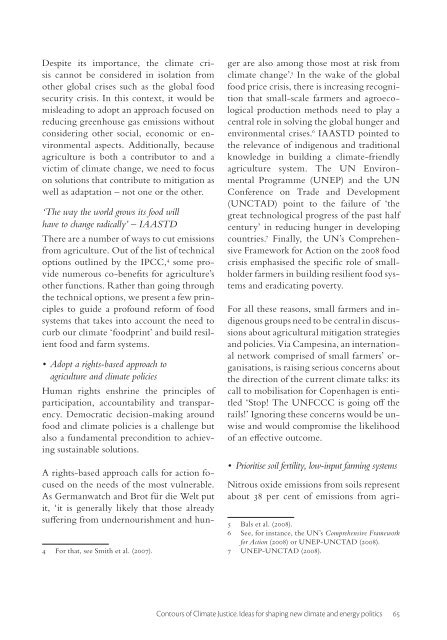Contours of Climate Justice - Dag Hammarskjöld Foundation
Contours of Climate Justice - Dag Hammarskjöld Foundation
Contours of Climate Justice - Dag Hammarskjöld Foundation
Create successful ePaper yourself
Turn your PDF publications into a flip-book with our unique Google optimized e-Paper software.
Despite its importance, the climate crisis<br />
cannot be considered in isolation from<br />
other global crises such as the global food<br />
security crisis. In this context, it would be<br />
misleading to adopt an approach focused on<br />
reducing greenhouse gas emissions without<br />
considering other social, economic or environmental<br />
aspects. Additionally, because<br />
agriculture is both a contributor to and a<br />
victim <strong>of</strong> climate change, we need to focus<br />
on solutions that contribute to mitigation as<br />
well as adaptation – not one or the other.<br />
‘The way the world grows its food will<br />
have to change radically’ – IAASTD<br />
There are a number <strong>of</strong> ways to cut emissions<br />
from agriculture. Out <strong>of</strong> the list <strong>of</strong> technical<br />
options outlined by the IPCC, 4 some provide<br />
numerous co-benefi ts for agriculture’s<br />
other functions. Rather than going through<br />
the technical options, we present a few principles<br />
to guide a pr<strong>of</strong>ound reform <strong>of</strong> food<br />
systems that takes into account the need to<br />
curb our climate ‘foodprint’ and build resilient<br />
food and farm systems.<br />
• Adopt a rights-based approach to<br />
agriculture and climate policies<br />
Human rights enshrine the principles <strong>of</strong><br />
participation, accountability and transparency.<br />
Democratic decision-making around<br />
food and climate policies is a challenge but<br />
also a fundamental precondition to achieving<br />
sustainable solutions.<br />
A rights-based approach calls for action focused<br />
on the needs <strong>of</strong> the most vulnerable.<br />
As Germanwatch and Brot für die Welt put<br />
it, ‘it is generally likely that those already<br />
suff ering from undernourishment and hun-<br />
4 For that, see Smith et al. (2007).<br />
ger are also among those most at risk from<br />
climate change’. 5 In the wake <strong>of</strong> the global<br />
food price crisis, there is increasing recognition<br />
that small-scale farmers and agroecological<br />
production methods need to play a<br />
central role in solving the global hunger and<br />
environmental crises. 6 IAASTD pointed to<br />
the relevance <strong>of</strong> indigenous and traditional<br />
knowledge in building a climate-friendly<br />
agriculture system. The UN Environmental<br />
Programme (UNEP) and the UN<br />
Conference on Trade and Development<br />
(UNCTAD) point to the failure <strong>of</strong> ‘the<br />
great technological progress <strong>of</strong> the past half<br />
century’ in reducing hunger in developing<br />
countries. 7 Finally, the UN’s Comprehensive<br />
Framework for Action on the 2008 food<br />
crisis emphasised the specifi c role <strong>of</strong> smallholder<br />
farmers in building resilient food systems<br />
and eradicating poverty.<br />
For all these reasons, small farmers and indigenous<br />
groups need to be central in discussions<br />
about agricultural mitigation strategies<br />
and policies. Via Campesina, an international<br />
network comprised <strong>of</strong> small farmers’ organisations,<br />
is raising serious concerns about<br />
the direction <strong>of</strong> the current climate talks: its<br />
call to mobilisation for Copenhagen is entitled<br />
‘Stop! The UNFCCC is going <strong>of</strong>f the<br />
rails!’ Ignoring these concerns would be unwise<br />
and would compromise the likelihood<br />
<strong>of</strong> an eff ective outcome.<br />
•<br />
Prioritise soil fertility, low-input farming systems<br />
Nitrous oxide emissions from soils represent<br />
about 38 per cent <strong>of</strong> emissions from agri-<br />
5 Bals et al. (2008).<br />
6 See, for instance, the UN’s Comprehensive Framework<br />
for Action (2008) or UNEP-UNCTAD (2008).<br />
7 UNEP-UNCTAD (2008).<br />
<strong>Contours</strong> <strong>of</strong> <strong>Climate</strong> <strong>Justice</strong>. Ideas for shaping new climate and energy politics 65
















